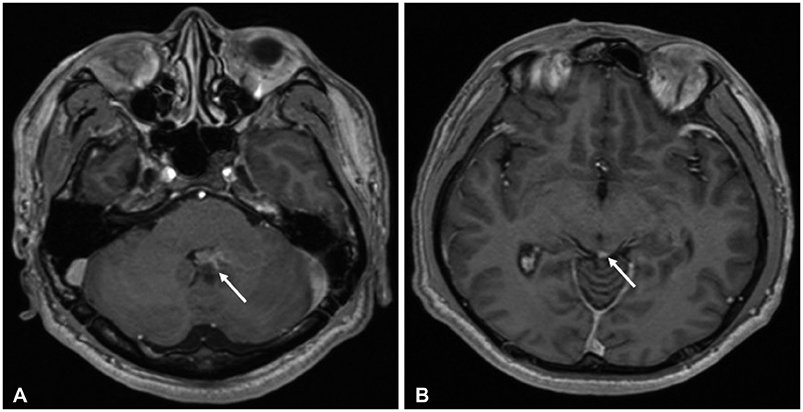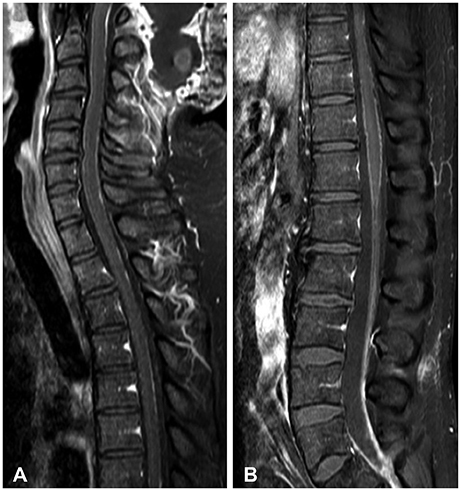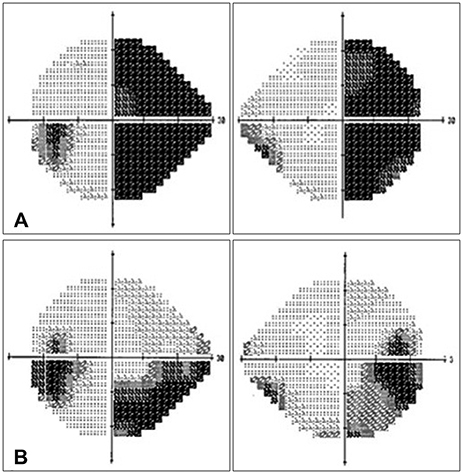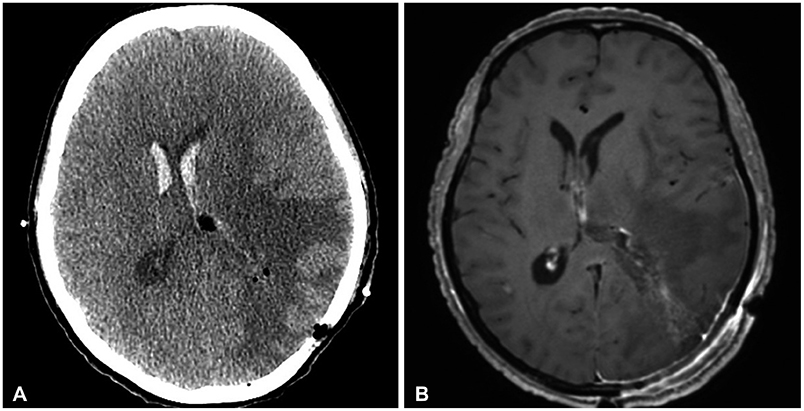Brain Tumor Res Treat.
2019 Apr;7(1):48-52. 10.14791/btrt.2019.7.e23.
Choroid Plexus Carcinoma in Adults: Two Case Reports
- Affiliations
-
- 1Department of Neurosurgery, Seoul National University College of Medicine, Seoul, Korea.
- 2Center for Pediatric Cancer, National Cancer Center, Goyang, Korea.
- 3Department of Pathology, National Cancer Center, Goyang, Korea.
- 4Deaprtment of Cancer Control, National Cancer Center, Graduate School of Cancer Science and Policy, Goyang, Korea. nsghs@ncc.re.kr
- KMID: 2444796
- DOI: http://doi.org/10.14791/btrt.2019.7.e23
Abstract
- Choroid plexus tumors are uncommon brain tumors that primarily occur in children. Most of these tumors originate from the intraventricular area, and the most common clinicalpresentation is increased intracranial pressure. Dissemination through the cerebrospinal fluid space is the inevitable natural course of the disease. Here, we present 2 rare cases of adult choroid plexus carcinoma (CPC), each with distinct clinical presentation and progression. The first case was a 40-year-old male who presented with multiple intraventricular masses. After surgical biopsy, radiation and intrathecal chemotherapy failed to elicit any response. The patient progressed with spinal cord dissemination and expired 1 year later. The second case presented with visual disturbance, and brain MRI revealed a large ovoid juxtaventricular mass with peritumoral edema. This 49-year-old female patient underwent craniotomy for what was thought to be a high-grade glioma; however, the mass was connected to the choroid plexus at the operative field. Her pathology specimen was diagnosed as CPC, and adjuvant systemic chemotherapy was administered. She has now been free of recurrence for 10 months. The description of the presentation and progression of these rare adult-onset CPC provides insight for the diagnosis and treatment of other rare instances of choroid plexus tumors.
MeSH Terms
Figure
Reference
-
1. Sun MZ, Oh MC, Ivan ME, et al. Current management of choroid plexus carcinomas. Neurosurg Rev. 2014; 37:179–192.
Article2. Ozdogan S, Gergin YE, Gergin S, et al. Choroid plexus carcinoma in adults: an extremely rare case. Pan Afr Med J. 2015; 20:302.
Article3. Bahar M, Hashem H, Tekautz T, et al. Choroid plexus tumors in adult and pediatric populations: the Cleveland Clinic and University Hospitals experience. J Neurooncol. 2017; 132:427–432.
Article4. Sav A, Scheithauer BW, Mazzola CA, Ketterling SR, Thompson SJ, Reilly MH. Oncocytic choroid plexus carcinoma: case report. Clin Neuropathol. 2010; 29:14–20.
Article5. Chow E, Reardon DA, Shah AB, et al. Pediatric choroid plexus neoplasms. Int J Radiat Oncol Biol Phys. 1999; 44:249–254.
Article6. Wrede B, Hasselblatt M, Peters O, et al. Atypical choroid plexus papilloma: clinical experience in the CPT-SIOP-2000 study. J Neurooncol. 2009; 95:383–392.
Article7. Gwak HS, Lee SH, Park WS, Shin SH, Yoo H, Lee SH. Recent advancements of treatment for leptomeningeal carcinomatosis. J Korean Neurosurg Soc. 2015; 58:1–8.
Article8. Guo P, Tang W, Li S, et al. Choroid plexus carcinoma in the external ventricle of an adult. J Craniofac Surg. 2015; 26:e664–e666.
Article9. Lozier AP, Arbaje YM, Scheithauer BW. Supratentorial, extraventricular choroid plexus carcinoma in an adult: case report. Neurosurgery. 2009; 65:E816–E817.10. Bohara M, Hirabaru M, Fujio S, et al. Choroid plexus tumors: experience of 10 cases with special references to adult cases. Neurol Med Chir (Tokyo). 2015; 55:891–900.
Article11. Yip CM, Tseng HH, Hsu SS. Choroid plexus carcinoma: a rare tumor in adult. Surg Sci. 2014; 5:146–149.
Article12. Gopal P, Parker JR, Debski R, Parker JC Jr. Choroid plexus carcinoma. Arch Pathol Lab Med. 2008; 132:1350–1354.
Article13. Wolff JE, Sajedi M, Coppes MJ, Anderson RA, Egeler RM. Radiation therapy and survival in choroid plexus carcinoma. Lancet. 1999; 353:2126.
Article14. Cannon DM, Mohindra P, Gondi V, Kruser TJ, Kozak KR. Choroid plexus tumor epidemiology and outcomes: implications for surgical and radiotherapeutic management. J Neurooncol. 2015; 121:151–157.
Article15. Fabi A, Salesi N, Di Cocco B, et al. Choroid plexus carcinoma in the adult: is there a role for chemotherapy. J Exp Clin Cancer Res. 2005; 24:493–496.
- Full Text Links
- Actions
-
Cited
- CITED
-
- Close
- Share
- Similar articles
-
- A Case of Choroid Plexus Carcinoma with Rapid Dissemination after Gross Total Resection
- Melanotic Choroid Plexus Carcinoma of the Posterior Fossa
- Surgical Outcome of Choroid Plexus Tumors in Adults : Experience of 5 Cases
- A Case of Lateral Ventricle Choroid Plexus Papilloma in a Child
- Choroid Plexus Carcinoma in an Adult







